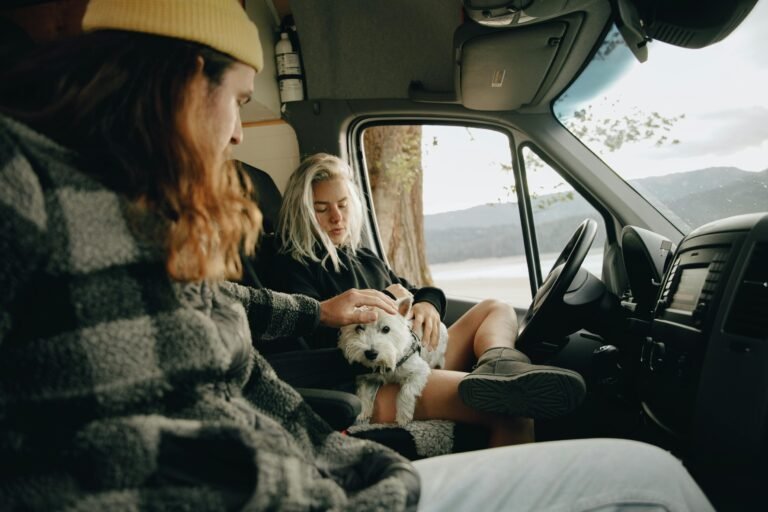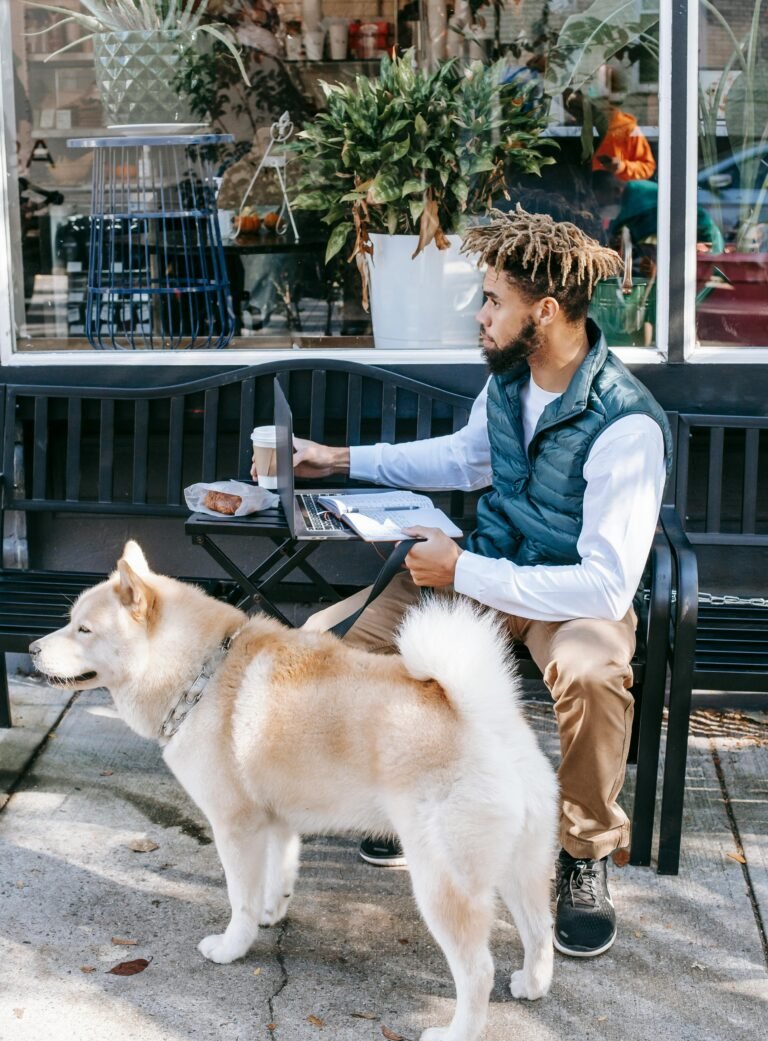Introduction
Traveling with your dog can be one of the most rewarding experiences you share together. From scenic road trips to exploring new cities and trails, including your canine companion in your adventures strengthens your bond and exposes your dog to new sights, smells, and experiences. However, dog-friendly travel also comes with unique considerations and responsibilities. Proper planning and preparation help ensure that both you and your dog stay comfortable, safe, and stress-free throughout the journey. In this comprehensive guide, we’ll walk you through every step of planning a dog-friendly vacation, from assessing whether your dog is ready to travel to choosing destinations, packing essentials, and navigating accommodation, transportation, and activities.
Decide if Your Dog Is Ready for Travel
Not every dog is an ideal travel companion. Before you start planning your trip, take an honest look at your dog’s physical health and temperament to determine whether travel is in their best interest.
- Health and age: Consult your veterinarian to make sure your dog is up to date on vaccinations and is healthy enough to travel. Senior dogs, puppies, and dogs with certain medical conditions may need special accommodations or might be better off staying home.
- Behavior and anxiety: Does your dog stay calm in new environments? If your dog becomes stressed around strangers or in unfamiliar settings, you may need to invest time in desensitization training or consider a pet sitter instead.
- Travel experience: If your dog has never been on a long car ride or stayed away from home, try short trips or overnight stays before committing to a longer vacation.
By assessing these factors, you can make informed decisions about the type and duration of travel that suits your dog’s needs.
Plan Your Itinerary with Your Dog in Mind
Once you’ve confirmed that your dog is ready for travel, it’s time to plan your trip around their comfort and happiness.
- Choose dog-friendly destinations: Look for places known for being welcoming to dogs, such as national parks with pet-friendly trails, coastal towns with dog beaches, or cities that have dog-friendly patios, parks, and attractions.
- Consider climate and season: Extreme heat or cold can be hard on dogs. Check the weather forecast for your destination and choose times of year when conditions are comfortable.
- Research accommodation: Not all hotels and vacation rentals allow pets. Use websites and apps that filter for pet-friendly lodging, and double-check pet policies and fees. Ask about weight limits, breed restrictions, and whether there are designated pet areas.
- Plan activities together: Identify dog parks, hiking trails, beaches, and dog-friendly tours in advance. Having a rough itinerary ensures you won’t find yourself searching for something to do with your dog while on vacation.
Preparing for the Trip
A successful trip starts with thorough preparation. Make sure you have everything your dog needs for comfort, safety, and health.
- Visit the veterinarian: Schedule a pre-trip checkup to ensure your dog is healthy and up to date on vaccinations. Ask your vet about preventive medication for heartworm, fleas, ticks, and travel-related diseases. If you’re traveling by air or crossing borders, you may need a health certificate.
- Identification and microchip: Make sure your dog wears a collar with current ID tags that include your contact information. If your dog is microchipped, verify that the registration is up to date. Bring a recent photo of your dog in case you need to make lost-pet posters.
- Packing essentials: Pack enough of your dog’s regular food, treats, and medications for the entire trip, plus a little extra in case of delays. Bring collapsible food and water bowls, a leash and harness, waste bags, grooming supplies, and a comfortable bed or blanket.
- First-aid kit: Prepare a canine first-aid kit that includes bandages, antiseptic wipes, tweezers, scissors, tick removal tools, and any necessary prescription medications. Knowing basic first aid can help you handle minor injuries on the road.
- Comfort items: Bring familiar toys, blankets, or clothing with your scent to help your dog feel secure in unfamiliar environments.
Travel by Car
Road trips are a popular choice for pet owners because they allow flexibility and frequent stops. To keep your dog safe and comfortable on the road:
Ease motion sickness: Avoid feeding your dog a large meal right before departure. Provide small amounts of water and offer ginger treats or consult your vet about medication if your dog suffers from motion sickness.ntroduction
Use a restraint: Unrestrained dogs can distract drivers and risk injury. Use a crash-tested seat belt harness, car seat, or travel crate secured with a seat belt. Make sure your dog can sit, stand, and lie down comfortably.
Plan rest stops: Stop every two to three hours to let your dog stretch, relieve themselves, and drink water. Choose rest areas or parks away from busy roads.
Keep the car cool and ventilated: Dogs are sensitive to heat. Use air conditioning or crack windows for fresh air, and never leave your dog unattended in a parked car, even with the windows open.
Traveling with your dog can be one of the most rewarding experiences you share together. From scenic road trips to exploring new cities and trails, including your canine companion in your adventures strengthens your bond and exposes your dog to new sights, smells, and experiences. However, dog-friendly travel also comes with unique considerations and responsibilities. Proper planning and preparation help ensure that both you and your dog stay comfortable, safe, and stress‑free throughout the journey. In this comprehensive guide, we’ll walk you through every step of planning a dog-friendly vacation, from assessing whether your dog is ready to travel to choosing destinations, packing essentials, and navigating accommodation, transportation, and activities.
Decide if Your Dog Is Ready for Travel
Not every dog is an ideal travel companion. Before you start planning your trip, take an honest look at your dog’s physical health and temperament to determine whether travel is in their best interest.
- Health and age: Consult your veterinarian to make sure your dog is up to date on vaccinations and is healthy enough to travel. Senior dogs, puppies, and dogs with certain medical conditions may need special accommodations or might be better off staying home.
- Behavior and anxiety: Does your dog stay calm in new environments? If your dog becomes stressed around strangers or in unfamiliar settings, you may need to invest time in desensitization training or consider a pet sitter instead.
- Travel experience: If your dog has never been on a long car ride or stayed away from home, try short trips or overnight stays before committing to a longer vacation.
By assessing these factors, you can make informed decisions about the type and duration of travel that suits your dog’s needs.
Plan Your Itinerary with Your Dog in Mind
Once you’ve confirmed that your dog is ready for travel, it’s time to plan your trip around their comfort and happiness.
- Choose dog‑friendly destinations: Look for places known for being welcoming to dogs, such as national parks with pet‑friendly trails, coastal towns with dog beaches, or cities that have dog‑friendly patios, parks, and attractions.
- Consider climate and season: Extreme heat or cold can be hard on dogs. Check the weather forecast for your destination and choose times of year when conditions are comfortable.
- Research accommodation: Not all hotels and vacation rentals allow pets. Use websites and apps that filter for pet‑friendly lodging, and double‑check pet policies and fees. Ask about weight limits, breed restrictions, and whether there are designated pet areas.
- Plan activities together: Identify dog parks, hiking trails, beaches, and dog‑friendly tours in advance. Having a rough itinerary ensures you won’t find yourself searching for something to do with your dog while on vacation.
Preparing for the Trip
A successful trip starts with thorough preparation. Make sure you have everything your dog needs for comfort, safety, and health.
- Visit the veterinarian: Schedule a pre‑trip checkup to ensure your dog is healthy and up to date on vaccinations. Ask your vet about preventive medication for heartworm, fleas, ticks, and travel‑related diseases. If you’re traveling by air or crossing borders, you may need a health certificate.
- Identification and microchip: Make sure your dog wears a collar with current ID tags that include your contact information. If your dog is microchipped, verify that the registration is up to date. Bring a recent photo of your dog in case you need to make lost‑pet posters.
- Packing essentials: Pack enough of your dog’s regular food, treats, and medications for the entire trip, plus a little extra in case of delays. Bring collapsible food and water bowls, a leash and harness, waste bags, grooming supplies, and a comfortable bed or blanket.
- First‑aid kit: Prepare a canine first‑aid kit that includes bandages, antiseptic wipes, tweezers, scissors, tick removal tools, and any necessary prescription medications. Knowing basic first aid can help you handle minor injuries on the road.
- Comfort items: Bring familiar toys, blankets, or clothing with your scent to help your dog feel secure in unfamiliar environments.
Travel by Car
Road trips are a popular choice for pet owners because they allow flexibility and frequent stops. To keep your dog safe and comfortable on the road:
- Use a restraint: Unrestrained dogs can distract drivers and risk injury. Use a crash‑tested seat belt harness, car seat, or travel crate secured with a seat belt. Make sure your dog can sit, stand, and lie down comfortably.
- Plan rest stops: Stop every two to three hours to let your dog stretch, relieve themselves, and drink water. Choose rest areas or parks away from busy roads.
- Keep the car cool and ventilated: Dogs are sensitive to heat. Use air conditioning or crack windows for fresh air, and never leave your dog unattended in a parked car, even with the windows open.
- Ease motion sickness: Avoid feeding your dog a large meal right before departure. Provide small amounts of water and offer ginger treats or consult your vet about medication if your dog suffers from motion sickness.
Travel by Air
Flying with your dog requires advance planning and compliance with airline regulations.
- Check airline policies: Each airline has different rules regarding pets. Some allow small dogs in the cabin, while others require pets to travel in cargo. Review size and weight limits, carrier requirements, and fees.
- Book direct flights: Direct flights reduce stress and minimize the risk of lost luggage (or pets). Avoid traveling during extreme temperatures that could affect cargo holds.
- Choose an approved carrier: Use an airline‑approved pet carrier that is large enough for your dog to stand and turn around. Line the carrier with absorbent material and include a water bottle.
- Prepare your dog: Familiarize your dog with the carrier well before your trip. Take short practice runs and reward your dog for calmly staying inside.
- Documentation: Bring your dog’s health certificate, vaccination records, and any necessary permits if traveling internationally.
Staying in Dog‑Friendly Accommodations
Once you arrive, you’ll want to create a homey environment and respect the property.
- Review house rules: Even pet‑friendly accommodations have guidelines. Ask whether dogs are allowed on furniture, whether there are designated pet areas, and if there are additional cleaning fees.
- Pet‑proof the space: Look around for hazards like exposed wires, toxic plants, or small objects your dog might swallow. Move breakables out of reach.
- Bring familiar items: Your dog’s bed, toys, and blankets can help them settle in quickly. A crate provides a safe space if you need to leave the room briefly.
- Respect neighbors: Keep barking to a minimum and supervise your dog in shared spaces. If your dog is prone to separation anxiety, arrange pet‑sitting or take your dog with you.
Exploring New Places with Your Dog
Exploring together is one of the highlights of traveling with a dog. To make the most of your adventures:
- Introduce new environments gradually: Start with quiet walks around your accommodations to help your dog acclimate. Let them sniff and explore at their own pace.
- Leash up: Unless you’re in a designated off‑leash area, keep your dog on a leash to protect wildlife, respect other travelers, and keep your dog safe from hazards like traffic or cliffs.
- Watch for stress signals: Signs like panting, drooling, yawning, or lip licking can indicate stress. Offer water breaks, shade, and reassurance, and be ready to cut activities short if your dog seems overwhelmed.
- Mind local wildlife and plants: Be aware of potential dangers such as snakes, ticks, toxic plants, and sharp rocks. Keep your dog away from wildlife and stick to trails.
Dog‑Friendly Activities
Many destinations offer activities that cater to canine companions.
- Hiking and nature walks: Research trails that allow dogs and check whether they require leashes. Bring a map, plenty of water, and snacks for both you and your dog.
- Beach days: Look up dog‑friendly beaches and understand their rules. Bring fresh water, shade, and rinse off salt and sand afterward.
- Urban adventures: Many cities welcome dogs at outdoor patios, breweries, and markets. Train your dog to settle under the table and be mindful of crowded areas.
- Sports and classes: Look for local dog sports such as agility, dock diving, or paddleboarding. Participating in structured activities keeps your dog mentally and physically engaged.
Etiquette and Safety
Being a considerate traveler ensures that destinations remain open to dogs.
- Pick up after your dog: Always carry waste bags and dispose of them properly. Leaving waste behind can harm local ecosystems and cause communities to restrict dogs.
- Follow rules and regulations: Observe leash laws, restricted areas, and quiet hours. Noncompliance can result in fines and negative experiences for other dog owners.
- Respect other people and animals: Not everyone loves dogs. Keep your dog from jumping on strangers or approaching other dogs without permission.
- Stay vigilant: Keep an eye out for hazards like hot pavement, sharp shells, or harmful insects. Carry fresh water and avoid allowing your dog to drink from stagnant bodies of water.
Returning Home
The trip doesn’t end when you return home. Help your dog transition back to normal life.
- Allow time to decompress: Your dog may be tired or overstimulated. Provide a quiet space and maintain a calm routine.
- Monitor health: Watch for signs of illness or injury acquired during the trip, such as ticks, digestive upset, or cuts.
- Reflect and adjust: Think about what went well and what could be improved for future travels. Each trip is a learning experience.
Conclusion
A dog‑friendly vacation requires more thought than a solo trip, but the joy of exploring new places with your best friend makes it well worth the effort. By evaluating your dog’s readiness, planning around their needs, packing essential supplies, and practicing good etiquette, you can enjoy safe, stress‑free adventures together. With careful preparation and a flexible attitude, your next getaway could become both your favourite memory and your dog’s too.






